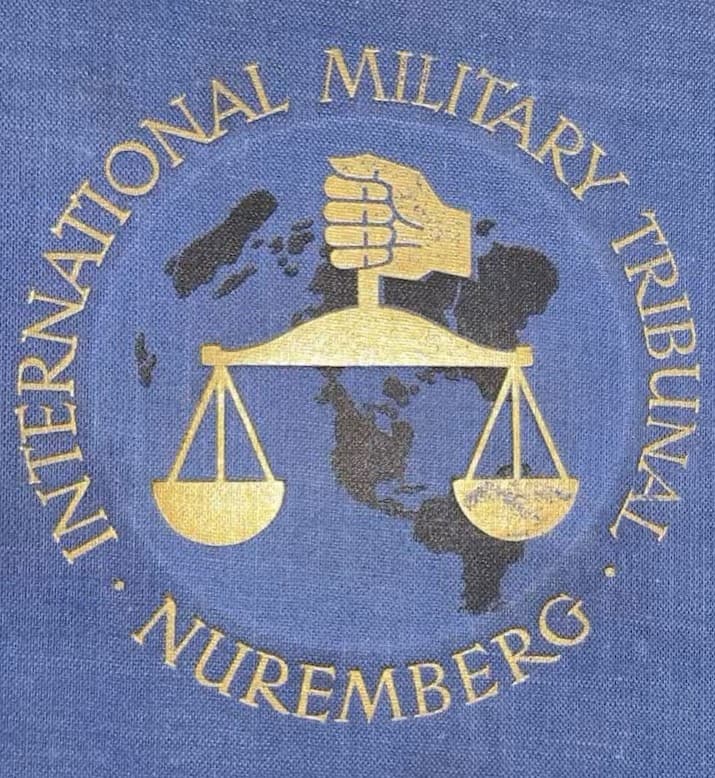Wiener Kurier (February 8, 1946)
‚Friedensengel‘ Rudolf Heß
Nürnberg, 8. Februar (AND) - Dem Internationalen Gerichtshof unterbreitete gestern der britische Anklagevertreter Oberst Griffith Jones das Belastungsmaterial gegen den Angeklagten Rudolf Heß, der im Jahre 1941 nach Schottland flog. Griffith Jones legte das Protokoll der Zeugenaussage des Herzogs von Hamilton vor, der im Mai 1941 mit Rudolf Heß nach dessen Fallschirmlandung in England eine Unterredung hatte.
Der Herzog machte am Samstag, den 11. Mai 1941, Dienst im Beobachtungsraum des britischen Flugzeugabwehrdienstes an der Küste von Northumberland. Um 22,08 Uhr wurde ein feindliches Flugzeug gesichtet und als Jagdflugzeug der Type „Messerschmitt 110“ identifiziert. Ein britischer Jäger nahm die Verfolgung auf, worauf der Insasse des deutschen Flugzeuges eine Fallschirmlandung vornahm und gefangengenommen wurde. Er gab seinen Namen als Alfred Horn an und erklärte, er käme in einer Sondermission und wünsche den Herzog von Hamilton zu sprechen. Seine Absicht sei gewesen, auf der Besitzung des Herzogs „Dungavel“ zu landen. Auf diese Nachricht begab sich der Herzog von Hamilton, welcher als Geschwaderführer in der britischen Luftwaffe diente, mit dem Untersuchungsoffizier zu dem Gefangenen.
Der Bericht des Herzogs von Hamilton
In der Zeugenaussage des Herzogs heißt es: „Ich betrat in Begleitung des vernehmenden Offiziers der Wachmannschaft den Raum, in dem sich der Gefangene aufhielt. Der Gefangene, den ich mich nicht erinnern konnte, vorher gesehen zu haben, stellte sofort die Bitte, mich unter vier Augen zu sprechen. Ich ersuchte daraufhin die beiden anderen Offiziere uns allein zu lassen, welcher Bitte diese nachkamen. Der Deutsche sagte: „Ich weiß nicht, ob Sie mich erkennen. Ich bin Rudolf Heß. Er erklärte, er sei in der Sache der Menschlichkeit nach England gekommen; der Führer wünsche die Niederlage Englands nicht und wolle den Krieg beenden.“
Heß sagte, sein Freund Professor Albrecht Haushofer hätte ihm erzählt, daß ich ein Engländer sei, der seinen Standpunkt verstehen würde. Er hätte schon vorher versucht, ein Treffen mit mir in die Wege zu leiten, und Haushofer hatte in dieser Sache am 20. September 1940 einen Brief an mich gerichtet, der den Akten beiliegt.
Ich befragte ihn, wie er sich eine Beendigung des Krieges’ vorstelle. Er erwiderte, eine der Bedingungen sei, daß England seine traditionelle Politik des europäischen Gleichgewichts aufgebe. Ich erwiderte, daß, wenn wir heute Frieden schlössen, wir innerhalb von zwei Jahren einen neuen Krieg zu gewärtigen hätten, und erklärte ihm, daß, wenn ein friedliches Übereinkommen möglich gewesen wäre, dieses vor Abbruch des Krieges hätte abgeschlossen werden müssen. Deutschland habe, sagte ich, den Krieg vorgezogen, zu einer Zeit, als wir alles taten, um den Frieden zu erhalten. Ich hätte daher wenig Hoffnung auf das Zustandekommen einer friedlichen Beendigung des Konfliktes.
‚Diplomat auf Besuch‘
Heß bat mich sodann, ihn gegen Ehrenwort freizulassen, da er unbewaffnet und freiwillig gekommen sei. Er ersuchte mich ferner, seine Familie von seiner sicheren Ankunft zu verständigen, und stellte das Ansinnen, ich solle an die Deckadresse Macker, Herzogstraße in Zürich, telegraphieren: Alfred Horn ist gesund. Er bat mich ferner darum, seine Identität der Presse nicht bekanntzugeben.
Heß war tief beleidigt, weil er als Kriegsgefangener und nicht als Diplomat auf Besuch behandelt wurde. Besonders beschwerte er sich darüber, daß er von einem gemeinen Soldaten bewacht wurde. Außerdem weigerte er sich, auf ein Kreuzverhör zu antworten, da, wie er sagte, dies „eines Reichsministers unwürdig“ sei.
Das Ehrenwort ‚im Namen des Führers‘
Heß versicherte, er kenne den Führer lange und genau und könne sein Ehrenwort geben, daß Hitler keine Pläne gegen das britische Weltreich habe. Hitler habe nie geplant, die Welt zu beherrschen. Heß behauptete, die Amerikaner wollten Kanada annektieren und schlug vor, England solle Deutschland freie Hand in Europa geben, dafür würde Deutschland das britische Weltreich nicht antasten, mit Ausnahme der deutschen Kolonien, die Deutschland als Rohstoffquellen zurückerhalten müßte.
Der Angeklagte erneuerte, Deutschland hätte keine Angst vor einem Eintritt Amerikas in den Krieg, es rechne im Gegenteil damit. Die englische und amerikanische Flugzeugproduktion zusammen könne mit Leichtigkeit von der deutschen Flugzeugerzeugung überflügelt werden. Im selben Atemzuge erklärte Heß, Deutschland habe keine Angriffsabsichten gegen Amerika, und es sei Hitler nur darum zu tun, das britische Weltreich intakt zu erhalten. Heß betonte, sein Flug habe den Zweck, England die Möglichkeit zu geben, ohne Prestigeverlust Friedensverhandlungen einzuleiten, Sollte England dies zurückweisen, dann würde es das Recht, ja die Pflicht des Führers sein, England gänzlich zu zerstören und nach dem Krieg in einem Zustand dauernder Abhängigkeit zu halten. Sollte es zu Verhandlungen kommen, sagte Heß, so wünsche er die Anwesenheit des deutschen Kriegsgefangenen Semmelbauer, der damals unter der Nummer 44.012 im Gefangenenlager Juyton interniert war, sowie eines deutschen Stenographen.
Ribbentrop: ‚Der Führer ist außer sich‘
Anschließend kam im Nürnberger Prozeß Mussolinis Interesse an Heß Flug nach Schottland zur Sprache. Der englische Ankläger Oberst Griffith legte als Beweis das offizielle Protokoll eines am 13. Mai 1941 im Palazzo Venezia in Rom stattgefundenen Gespräches zwischen Ribbentrop und Mussolini vor. Auch der damalige italienische Außenminister Graf Ciano war anwesend. In dem Dokument heißt es: „Ribbentrop erklärte Mussolini gegenüber, der Führer sei über Heß Handlung vollkommen außer sich. Es handle sich um die Tat eines Wahnsinnigen.
Heß, so sagte Ribbentrop, habe lange an einem Gallenleiden gelitten und war Magnetiseuren und Naturheilpraktikern in die Hände gefallen, wodurch sich sein Gesundheitszustand nicht besserte. Heß hatte, Ribbentrop zufolge, wochenlang geheime Übungsflüge in einer Messerschmitt 110 abgehalten. Natürlich hätte er nur aus „idealistischen Gründen,“ so gehandelt Eine Untreue gegen den Führer komme nicht in Frage.
Mussolini teilte die Ansicht Ribbentrops, daß Heß kein Verräter sei, und auch vom politischen Standpunkt aus nahm er die Folgen dieses Unternehmens nicht ernst.“
„Ribbentrop sagte, Papen sei nach Deutschland zurückberufen und beauftragt worden, zu versuchen, von der Türkei die Erlaubnis zu einem geheimen Waffentransport über türkisches Gebiet für den Irak zu erhalten. Wenn ein größerer Waffentransport im Irak eintrifft, wäre es möglich, Fallschirmtruppen in dieses Gebiet zu bringen, die dann mit dem dort Vorgefundenen Material gegen die Engländer Vorgehen und unter gewissen Umständen Ägypten vom Irak her angreifen könnten.
Der Duce war auch der Ansicht, daß dem Irak endgültig geholfen werden müßte, um eine neue Front gegen die Engländer zu schaffen.“











